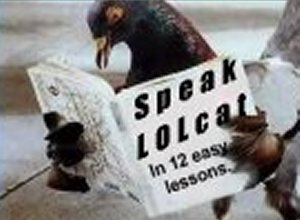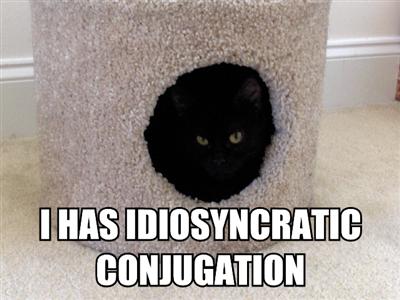
As any fule kno, the internet was invented as a medium for geeks to exchange amusingly-captioned pictures of cats – the rest is just bandwidth noise. This charming folk-custom has over the years burgeoned into a fully-fledged lolcat culture with customs and a language all of its own. Language blogger Anil Dash digs for the roots of lolcat grammar:
If you spend any time at all observing net culture, then you’ll have been unable to miss the recent explosion in popularity of lolcats. This relatively recent phenomenon is the convention of taking pictures of cute animals, most frequently cats, and overlaying absurdist captions on the images.
The core behavior has existed for some time; “Image macro” is a generic term for this kind of folk art, and cats have always featured heavily in these types of Internet in-jokes. But a few distinct categories have sprung up that have helped amplify and popularize the phenomenon.
- I’M IN UR X Ying your Z. This construct, based on i’m in ur base, killin ur d00ds has morphed into a catch-all structure for annotating cat pictures.
- Invisible Item. Variations on the seminal Invisible Bike, these are images of cats, usually in midair, with captions that prompt us to fill in imaginary objects or actions that complete the scene. There’s something brilliant to these images, speaking to our mind’s ability to intuitively extrapolate unseen details.
- Kitty Pidgin. And finally, the newly dominant lolcats, of the family I Can Has Cheezeburger? These seem to be spawning nearly infinite variations, and have exploded in popularity since being named “lolcats” instead of the more general “image macro” or “cat macro”.
The rise of these new subspecies of lolcats are particularly interesting to me because “I can has cheezeburger?” has a fairly consistent grammar. I wasn’t sure this was true until I realized that it’s possible to get cat-speak wrong.
Incorrect kitty pidgin jumped to my attention the first time I saw a reference to Dune being used with a lolcat image. The caption on the linked version of the image, “The spice must flow.” is fine, if not particularly cat-like. But the caption on the version I saw first was much more verbose: “I are dunecat. I controls the spice, I controls the universe.” Besides being an awkward attempt at overexplaining the punchline (I’ve never read Dune or seen the film, but the joke is obvious) this was just all wrong. The fact that we can tell no cat would talk like this shows that kitty pidgin is actually quite consistent.
I was having a conversation with Ben and Ben a few weeks ago where I suggested this consistent grammar for lolcats could be a “cweeole”. Knowing a bit more about such things now, I realize this isn’t a creole but more likely a pidgin language, used to help cats talk to humans. And since “pidgin” is already a cutesy spelling of a mispronunciation, there doesn’t seem to be any really cute way to rename it to reflect its uniqueness. “Kitty pidgin” might be the closest thing we have to a name for this new language.
Oh dear, the academics are on it now. I await the publication of the groundbreaking paper, “Towards an etiology of lol and hai – the semiotics of feline imagery and the developent of language in the floating world.” with interest.
Bloody hell, that actually sounds like quite a believable reserach topic. Anyone got a ESRC funding form handy?
